Sarkar N. (ed.) Human-Robot Interaction
Подождите немного. Документ загружается.


Hand Posture Segmentation, Recognition and Application for Human-Robot Interaction
501
a) b)
Figure 3. (a) Architecture of RCE neural network for hand segmentation, (b) Distribution
region of skin colors in L*a*b* color space
2.2 Hand Segmentation
During training procedure, the RCE network allocates the positions of prototype cells and
modifies the sizes of their corresponding spherical influence fields, so as to cover arbitrarily
complex distribution region of skin colors in the color space. Fig 3(b) shows the distribution
region of skin colors constructed by skin color prototype cells and their spherical influence
fields in the L*a*b* color space. During running, the RCE network responds to input color
signals in the fast response mode. If an input color signal falls into the distribution region of
skin colors, this input color signal is classified into the skin color class, and the pixel
represented by this color signal is identified as skin texture in the image.
During running, the RCE network identifies all the skin-tone pixels in the image. There are
occasions that other skin-tone objects such as faces are segmented, or some non-skin pixels
are falsely detected due to the effects of lighting conditions. We assume the hand is the
largest skin-tone object in the image, and use the technique of grouping by connectivity of
primitive pixels to further identify the region of the hand. With abundant skin color
prototype cells together with their different spherical influence fields, the RCE network is
capable of accurately characterizing the distribution region of skin colors in the color space
and efficiently segment various hand images under variable lighting conditions from
complex backgrounds after having been trained properly. Fig. 4 shows some segmentation
results, in that the hand regions are separated perfectly from the complex backgrounds. The
RCE neural network based hand image segmentation algorithm is described in more detail
in our paper [Yin et al., 2001].
3. 2D Hand Posture Recognition
Hand segmentation is followed by feature extraction. Contour is the commonly used feature
for accurate recognition of hand postures, and can be extracted easily from the silhouette of the
segmented hand region. Segen and Kumar [Segen and Kumar, 1998] extracted the points along
the boundary where the curvature reaches a local extremum as 'local features', and used those
features that are labeled "peaks" or 'valleys' to classify hand postures. However, if the
boundary is not smooth and continuous, it is difficult to identify peaks and valleys correctly.
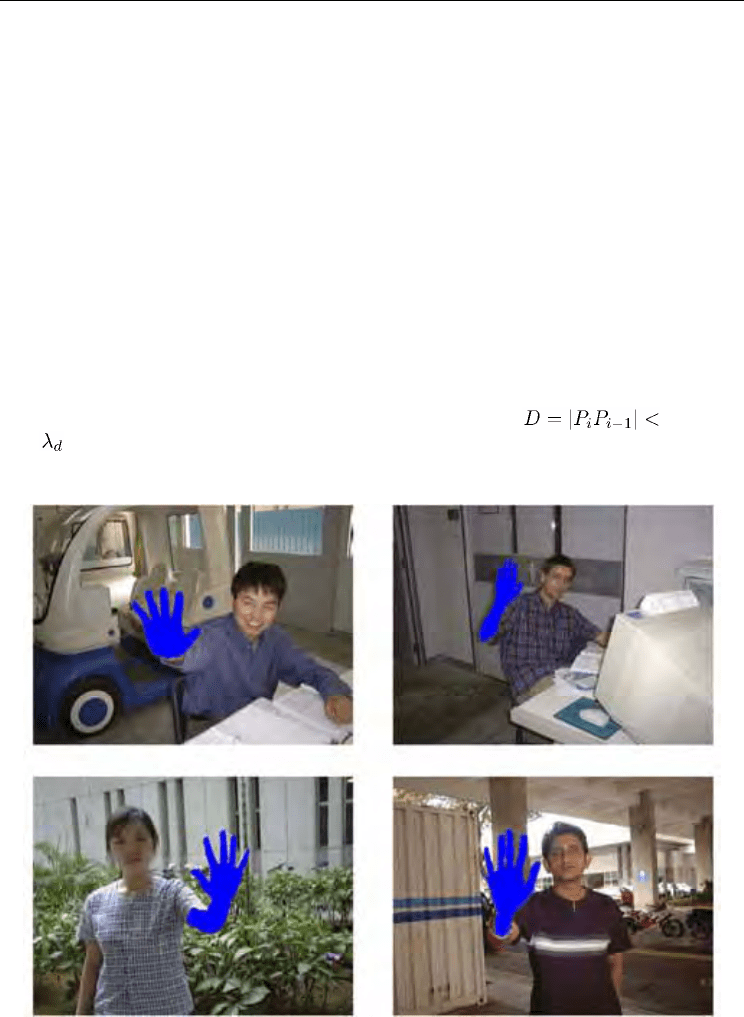
Human-Robot Interaction
502
In our study, we found it is difficult to extract the smooth and continuous contour of the
hand because the segmented hand region is irregular, especially when the RCE neural
network is not trained sufficiently. The topological features of the hand, such as the number
and positions of fingers, are other distinctive features of hand postures. In this section, we
present a new method for accurate recognition of hand postures, which extract topological
features of the hand from the silhouette of the segmented hand region, and recognize hand
postures on the basis of the analysis of these features.
3.1 Feature Extraction
In order to find the number and positions of fingers, the edge points of fingers are the most
useful features. We extract these points using the following proposed algorithm:
1. Calculate the mass center of the hand from the binary image of the segmented hand
region, in that pixel value 0 represents the background and 1 represents the hand
image;
2. Draw the search circle with the radius r at the position of the center of mass;
3. Find all the points E = {P
i
, i = 0,1,2,..., n} that have the transition either from pixel value
0 to 1, or 1 to 0 along the circle;
4. Delete P
i
and P
i-1
, if the distance between two conjoint points threshold
;
5. Increment the radius r and iterate Step 2 to 4, until r >1/2 (the width of the hand
region).
Figure 4. Hand segmentation results
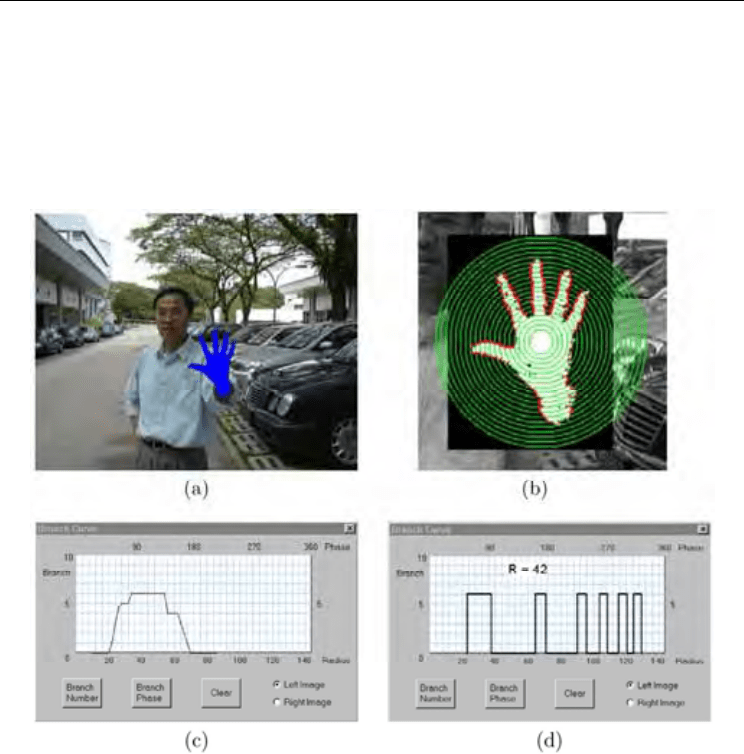
Hand Posture Segmentation, Recognition and Application for Human-Robot Interaction
503
The purpose of Step 4 is to remove the falsely detected edge points resulted from imperfect
segmentation. This step can removal most of falsely detected edge points. However, there
are still occasions that one finger is divided into several branches because there are big holes
in the image, or several fingers are merged into one branch because these fingers are too
close. So we define the branch as follows:
Definition 3.1 The branch is the segment between P
i-1
(0,1) and P
i
(l,0). Where P
i-1
(0,1) and P
i
(l,0)
are two conjoint feature points detected on the search circle. P
i-1
(0,1) has the transition from pixel
value 0 to 1, and P
i
(l,0) has the transition from 1 to 0.
Figure 5. (a) segmented hand image, (b) Feature points extracted from the binary image of
the segmented hand region, (c) Plot of branch number of the hand posture vs the radius of
the search circle, (d) Plot of branch phase of the hand posture on the selected search circle
A branch indicates the possible presence of a finger. Then the extracted feature points
accurately characterize the edge points of branches of the hand, including fingers and arm.
Fig. 5 (a) shows a segmented hand image. Fig. 5(b) shows the part of Fig. 5(a) with the scale
of 200%, in that the green circles represent the search circles and the red points represent the
extracted feature points.
For each branch, two edge points can be found on the search circle, so half of the feature
points found on the search circle just indicate the branch number of the hand posture. But
the feature points on the different search circles are varied, how to determine the correct
branch number is critical. In our method, we define the following function to determine the
possibility p
i
of each branch number:
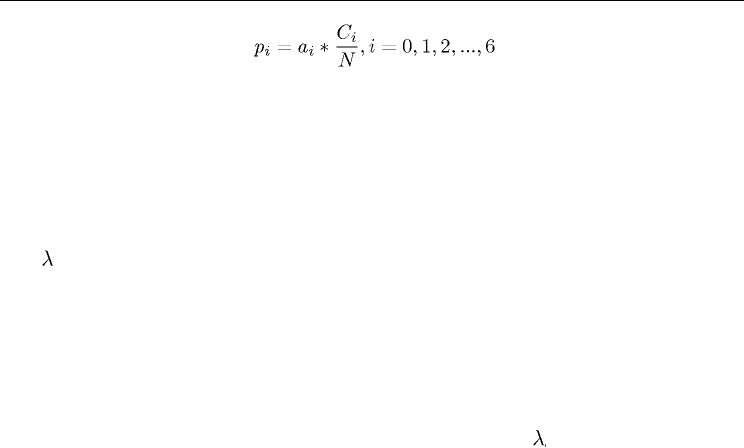
Human-Robot Interaction
504
(8)
Where C
i
is the number of the search circles on that there are i branches; N is the total
number of the search circles; a
i
is the weight coefficient. We have a
1
< a
2
< ... < a
i
< ... < a
6
,
because the number of the branches may decrease when the search circle is beyond the
thumb or little finger. Then the branch number with the biggest possibility is selected as the
most possible branch number BN.
In practice, the branch number BN can also be determined as follows:
1. Find all the branch numbers K (a set) whose occurrences are bigger than a threshold
n
.
2. Choose the biggest one as the branch number BN among the numbers in K,
The biggest number in K, but not the number with the most occurrence, is selected as BN,
because the biggest number may not have the most occurrence if there are some search
circles beyond the fingers. But when its occurrence is bigger than the threshold, it should be
the most possible branch number. For example, Fig. 5(c) shows the relationship between the
branch number and the radius of the search circle. In this case, branch number 5 occurs 7
times, and 0 occurs 15 times. However, we select 5 but not 0 as BN. This method is easier to
implement, and is very effective and reliable with the threshold
n
selected to be 6 in our
implementation.
After the branch number BN is determined, the branch phase can be obtained easily. Here
we define the branch phase as follows:
Definition 3.2 The branch phase is the positions of the detected branches on the search circle,
described by angle.
In our method, we selected the middle one of the search circles, on which there are BN
branches, to obtain the branch phase. Fig. 5 (d) shows the radius of the selected search circle,
and the branch phase on this circle.
Some morphological operations, such as dilation and erosion, are helpful for improvement
of the binary image of the segmented hand region, but the branch number and phase
obtained from the improved image are the same as those obtained from the original one. It
indicates that our feature extraction algorithm has good robustness to noise, and can extract
the correct branch number and phase reliably from the segmented hand image even though
the segmentation is not very good.
3.2 Posture Recognition
After the branch phase is determined, the width of each branch BWi can be obtained easily
from the branch phase. In most cases, the widest branch should be the arm. We use it as the
base branch
BQ. Then the distance from other branch B^ to BQ can be calculated, that is just
the distance between the finger and the arm BD^. Using these aforementioned parameters:
the branch number BN, the width of the branch BWi, the distance between the finger and the
arm BD^, the hand posture can be recognized accurately.
Although these parameters are all very simple and easy to estimate in real time, they are
distinctive enough to differentiate those hand postures defined explicitly. In addition, the
recognition algorithm also possesses the properties of rotational invariance and user
independence because the topological features of human hands are quite similar and stable.

Hand Posture Segmentation, Recognition and Application for Human-Robot Interaction
505
The postures shown in Fig. 6 all have distinctive features and are easy to recognize. We have
used them for gesture-based robot programming and human-robot interaction of a real
humanoid robot. The classification criterion of these postures is shown in Fig. 7. Preliminary
experiments were conducted with users of different age, gender and skin color. The robot
successfully recognized postures with the accuracy of more than 95% after the RCE network
was trained properly.
The recognition accuracy may decrease in the case that the user or lighting condition
changes too much, because the previous training of the RCE network becomes insufficient.
But this problem can be solved easily by selecting parts of undetected hand sections as the
training data using the mouse, and incrementally performing the online training. There is no
need to re-present the entire training set to the network. In addition, the proposed posture
recognition algorithm is only invariant to the hand rotation on the palm plane. If the hand is
rotated more than 10 degree on the plane perpendicular to the palm, the posture recognition
may be failed. The algorithms for topological feature extraction and hand posture
recognition are described in more detail in our paper [Yin and Xie, 2007].
4. 3D Hand Posture Reconstruction
All of the 3D hand models employed so far use 3D kinematic models of the hand. Two sets
of parameters are used in such models: angular (joint angles) and linear (phalange lengths
and palm dimensions). However, The estimation of these kinematic parameters is a complex
and cumbersome task because the human hand is an articulated structure with more than 27
degree of freedom. In this section, we propose to infer 3D information of the hand from the
images taken from different viewpoints and reconstruct hand gestures using 3D
reconstruction techniques.
4.1 Find robust matches
There are two approaches that can be used for the reconstruction of 3D vision models of
hand postures. The first is to use calibrated stereo cameras, and the second is to use
uncalibrated cameras. Camera calibration requires expensive calibration apparatus and
elaborate procedures, and is only valid for the space near the position of the calibration
object. Furthermore, the variation of focal lengths or relative positions of cameras will cause
the previous calibration invalid. These drawbacks make camera calibration not feasible for
gesture-based interaction, especially for human-robot interaction. Because service robots
usually operate in dynamic and unstructured environments and their cameras need to be
adjusted to track human hands frequently.
With uncalibrated stereo, there is an equivalence to the epipolar geometry which is
presented by the fundamental matrix [Luong and Faugeras, 1996]. We have proposed a new
method to estimate the fundamental matrix from uncalibrated stereo hand images. The
proposed method consists of the following major steps: extracting points of interest;
matching a set of at least 8 points; recovering the fundamental matrix.
In most approaches reported in the literature, high curvature points are extracted as points
of interest. In our method, we use the edge points of the extended fingers, which are similar
to those described in Section 3, as points of interest, and find robust matches from these
points.
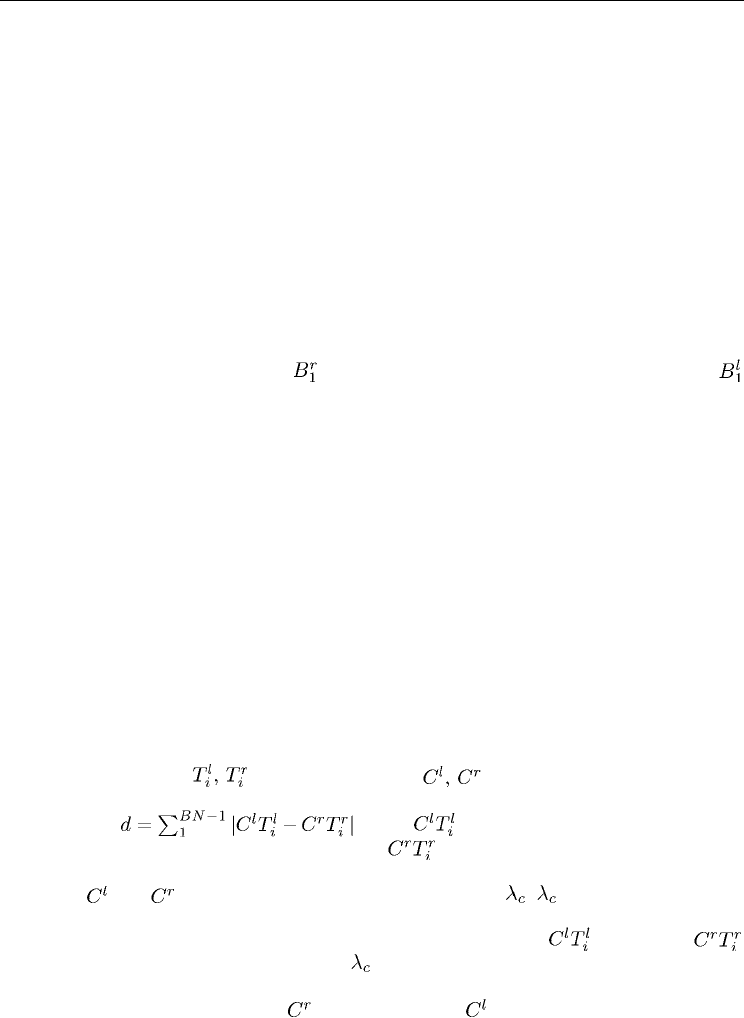
Human-Robot Interaction
506
Matching different images of a single scene remains one of the bottlenecks in computer
vision. A large amount of work has been carried out during the last decades, but the results
are not satisfactory. The numerous algorithms for image matching that have been proposed
can roughly be classified into two categories: correlation-based matching and feature-based
matching. Correlation-based methods are not robust for hand image matching due to the
ambiguity caused by the similar color of the hand. The topological features of the hand, such
as the number and positions of the extended fingers that are described in the above section,
are more distinct and stable in stereo hand images, only if the distance and angles between
two cameras are not too big. In our method, we propose to take advantage of the topological
features of the hand to establish robust correspondences between two perspective hand
images.
We first detect fingertips by searching the furthest edge points from the mass center of the
hand in the range between B
i
+BW
i
and B
i
— BW
i
. Here B
i
is the branch phase and BW
i
is the
branch width. The fingertips of two perspective hand images are found using this method ,
respectively. Simultaneously, their correspondences are established by the order of the
finger. For example, the fingertip of in the right image corresponds to the fingertip of
in the left image.
Then, we define the center of the palm as the point whose distance to the closest region
boundary is maximum, and use the morphological erosion operation to find it. The
procedure is as follows:
1. Apply dilation operation once to the segmented hand region.
2. Apply erosion operations until the area of the region becomes small enough. As a
result, a small region at the center of the palm is obtained.
3. Calculate the center of mass of the resulting region as the center of the palm.
The purpose of the first step is to remove little holes in the imperfectly segmented hand
image. These little holes can affect the result of erosion greatly. Fig. 8 shows the procedure
to find the center of the palm by erosion operations.
The palm centers of two hand images are found by this method, respectively. In most case,
they should correspond to each other because the shapes of the hand in two perspective
images are almost the same under the assumption that the distance and angle between two
cameras are small. However, because the corresponding centers of the palm are very critical
for finding matches in our approach, we further use the following procedure to evaluate the
accuracy of correspondence and determine the corresponding palm centers more robustly:
1. Find the fingertips
and the palm centers for the left image and right
image, respectively.
2. Calculate
. Here, is the distance between the palm
center and a fingertip in the left image, and
is that in the right image. (BN — 1)
represents the number of the extended fingers.
3. Take and as the corresponding palm centers if d < . is the threshold and is
set to 2 pixels in our implementation.
The evaluation procedure above is used because we can assume is equal to
according to projective invariance. If d > , we take the point, whose distance to each
fingertip in the right image is the same as the distance between the palm center and each
fingertip in the left image, as new
corresponding to . Such a point is determined in
theory by calculating the intersection of all the circles that are drawn in the right hand image
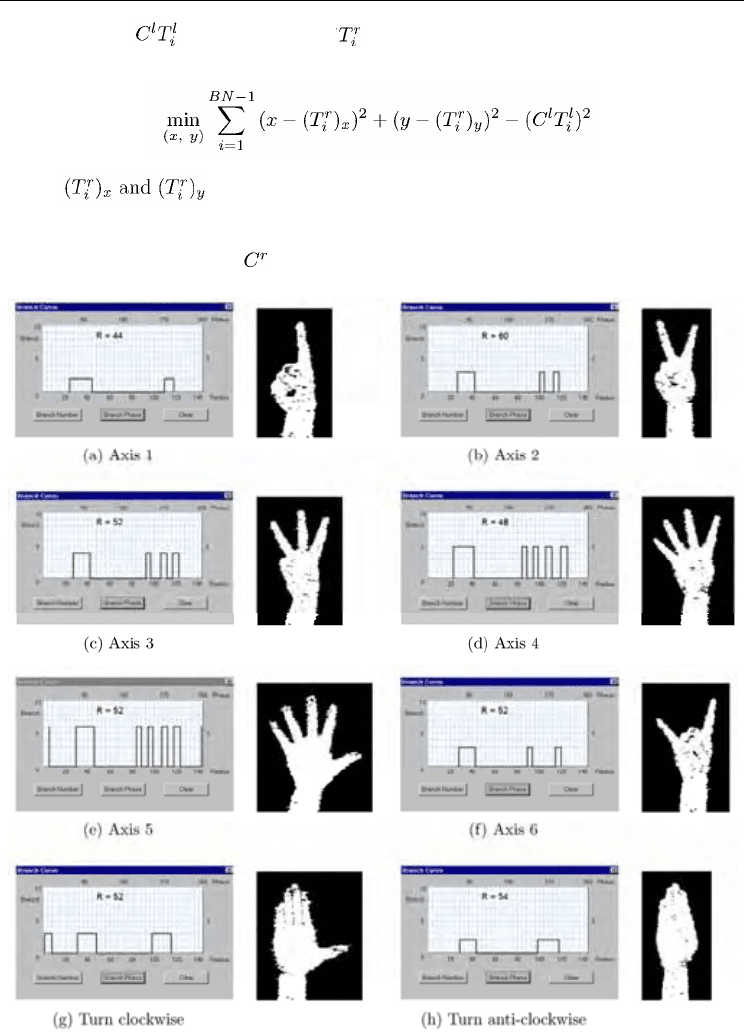
Hand Posture Segmentation, Recognition and Application for Human-Robot Interaction
507
with the radius at the positions of . Referring to the coordinates of this point as x
and y, they satisfy the following equation:
(9)
where,
denote the coordinates of a fingertip in the right image. Such an
equation is difficult to be solved by mathematical methods. In practice, we can determine an
intersection within the right hand region for every two circles, then calculate the mass center
of all the intersections as new
.
Figure 6. Hand postures used for robot programming and human-robot interaction
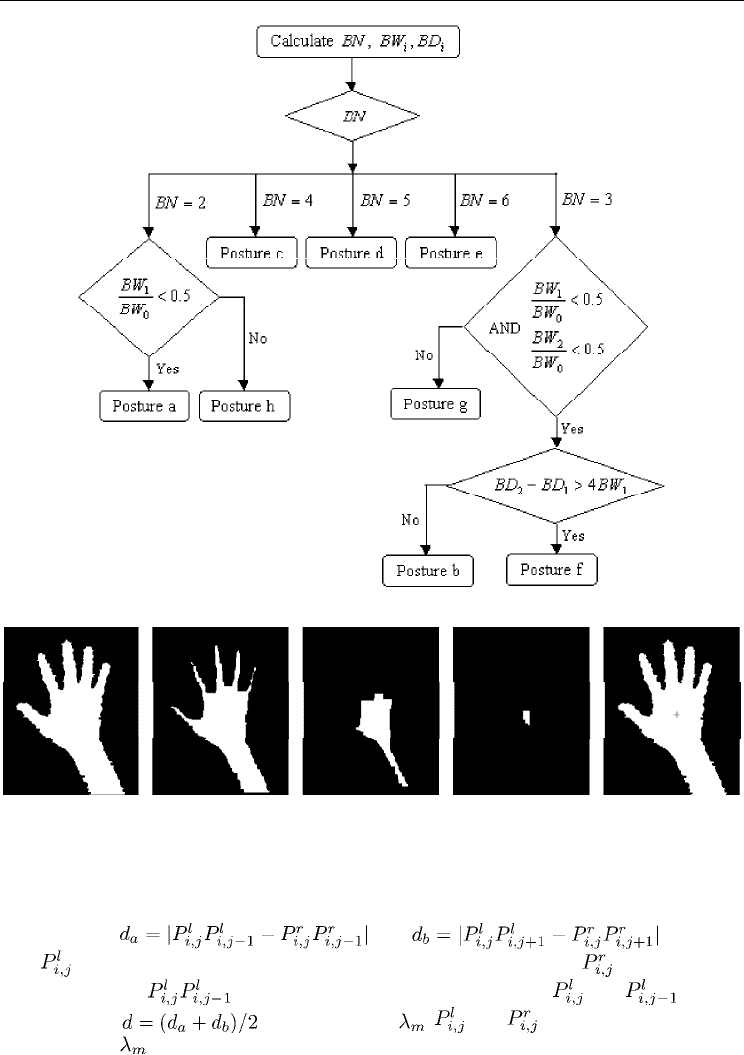
Human-Robot Interaction
508
Figure 7. Classsification criterion of hand postures
Figure 8. Procedure for finding the center of the palm by the morphological erosion
operation
After the corresponding palm centers are determined, matches can be found by comparing
the edge points on the i
th
(i = 1, ...,m) search circle of the left image with those of the right
image. The criterion is as follows:
1. Calculate
and . Here,
is the j
th
edge point on the i
th
search circle in the left image, and is that in the
right image. is the distance between the edge points and
2. Calculate . If d < threshold , and are taken as a pair of
matches.
is set to 2 pixels in our implementation.
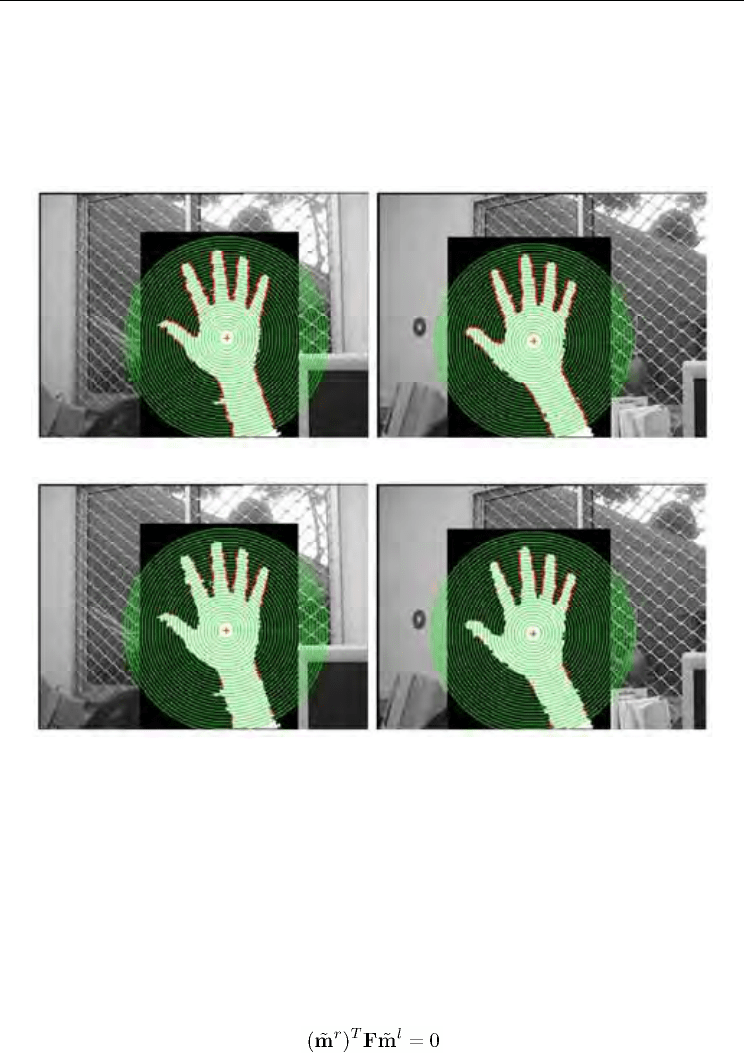
Hand Posture Segmentation, Recognition and Application for Human-Robot Interaction
509
The basic idea underlying this matching algorithm is to extract the edge points , whose
distances to its previous and following points as well as to the center of the palm are almost
identical in two images, as matches. The algorithm works very well under the situation that
the distance and angle between two cameras are small. In Fig. 9, (a) shows the edge points
extracted from the segmented hand regions of two perspective images and (b) shows the
matches extracted from these edge points. The green circles represent the search circles and
the red points are the extracted edge points.
(a)
(b)
Figure 9. (a) Edge points extractedfrom stereo hand images, (b) Matches extracted from edge
points
4.2 Estimate the Fundamental Matrix
Using the set of matched points established in the previous step, the epipolar geometry
between two uncali-brated hand images can be recovered. It contains all geometric
information that is necessary for establishing correspondences between two perspective
images, from which 3D structure of an object can be inferred.
The epipolar geometry is the basic constraint which arises from the existence of two
viewpoints [Faugeras, 1993]. Considering the case of two cameras, we have the following
fundamental equation:
(10)
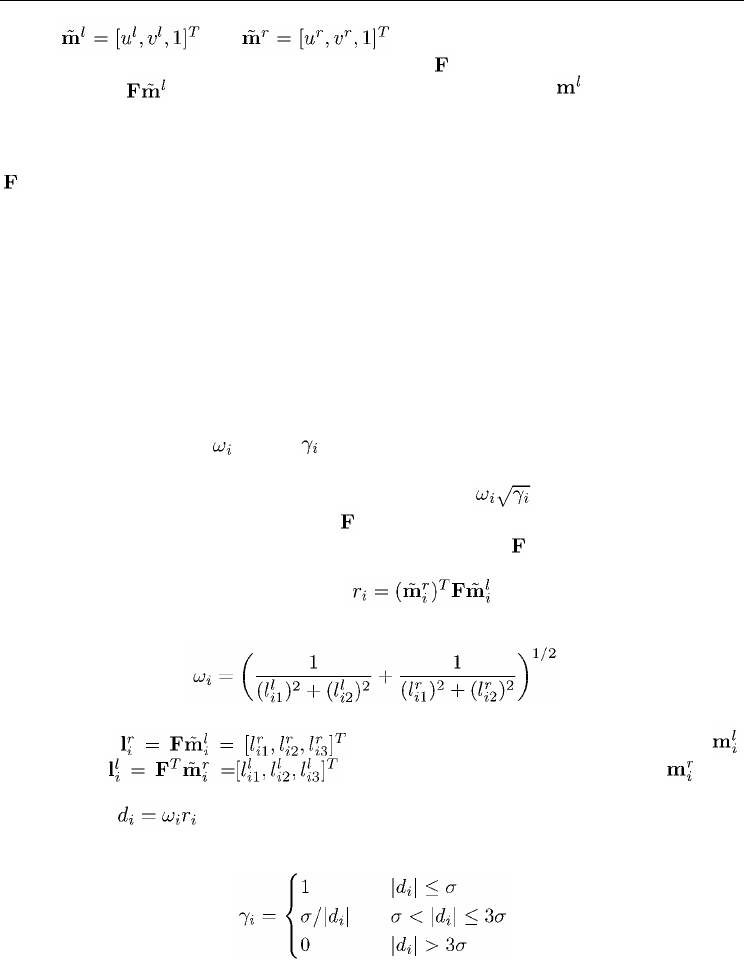
Human-Robot Interaction
510
where and are the homogeneous image coordinates of
a 3D point in the left and right images, respectively. is known as the fundamental matrix.
Geometrically, defines the epipolar line of a left image point in the right image.
Equation (10) says no more than that the correspondence in the right image of point m' lies
on the corresponding epipolar line. Transposing equation (10) yields the symmetric relation
from the right image to the left image.
is of rank 2. Besides, it is defined up to a scalar factor. Therefore, a fundamental matrix has
only seven degrees of freedom. That is, there are only 7 independent parameters among the 9
elements of the fundamental matrix. Various techniques have been reported in the literature
for estimation of the fundamental matrix (see [Zhang, 1996] for a review). The classical method
for computing the fundamental matrix from a set of 8 or more point matches is the 8-point
algorithm introduced by Longuet-Higgins in [Longuet-Higgins, 1981]. This method is the
linear criterion and has the advantage of simplicity of implementation. However, it is quite
sensitive to noise. In order to recover the epipolar geometry as accurately as possible, we use a
combination of techniques such as input data normalization, rank-2 constraint, linear criterion,
nonlinear criterion as well as robust estimator to yield an optimal estimation of the
fundamental matrix. The algorithm is as follows:
1. Normalize pixel coordinates of matches.
2. Initialize the weights
= 1 and = 1 for all matches.
3. For a number of iterations:
3.1. Weight the i
th
linear equation by multiplying it by .
3.2. Estimate the fundamental matrix
using the linear least-squares algorithm.
3.3. Impose the rank-2 constraint to the estimated by the singular value
decomposition.
3.4. Calculate the residuals of matches .
3.5. Calculate the nonlinear method weight:
(11)
here
i
gtne
corresponding epipolar line of point
and the corresponding epipolar line of point .
3.6. Calculate the distances between matching points and the corresponding epipolar
lines
.
3.7. Calculate the robust method weight:
(12)
By combining several simple methods together, the proposed approach becomes more
effective and robust, but still easily to be implemented.
